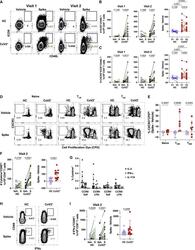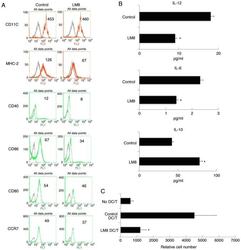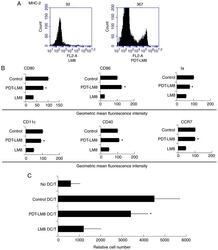46-1548-42
antibody from Invitrogen Antibodies
Targeting: CD40LG
CD154, CD40L, gp39, hCD40L, HIGM1, IMD3, TNFSF5, TRAP
Antibody data
- Antibody Data
- Antigen structure
- References [4]
- Comments [0]
- Validations
- Flow cytometry [1]
- Other assay [3]
Submit
Validation data
Reference
Comment
Report error
- Product number
- 46-1548-42 - Provider product page

- Provider
- Invitrogen Antibodies
- Product name
- CD154 (CD40 Ligand) Monoclonal Antibody (24-31), PerCP-eFluor™ 710, eBioscience™
- Antibody type
- Monoclonal
- Antigen
- Other
- Description
- Description: The 24-31 monoclonal antibody reacts with human CD154, a 39 kDa transmembrane glycoprotein also known as gp39 and CD40 ligand (CD40L). CD154 is a member of the TNF superfamily and is expressed transiently by activated T cells. Through its binding to CD40 on antigen presenting cells including B cells, monocytes/macrophages and dendritic cells, CD154 serves a crucial function in T-APC cognate interaction. CD154 interaction with CD40 transduces signals for T-dependent B-cell activation and induces B cell cycle entry. 24-31 cross-reacts with the cynomolgus monkey CD154. Applications Reported: This 24-31 antibody has been reported for use in flow cytometric analysis. Applications Tested: This 24-31 antibody has been pre-titrated and tested by flow cytometric analysis of stimulated normal human peripgheral blood cells. This can be used at 5 µL (0.06 µg) per test. A test is defined as the amount (µg) of antibody that will stain a cell sample in a final volume of 100 µL. Cell number should be determined empirically but can range from 10^5 to 10^8 cells/test. PerCP-eFluor® 710 can be used in place of PE-Cy5, PE-Cy5.5 or PerCP-Cy5.5. PerCP-eFluor® 710 emits at 710 nm and is excited with the blue laser (488 nm). Please make sure that your instrument is capable of detecting this fluorochrome. For a filter configuration, we recommend using the 685 LP dichroic mirror and 710/40 band pass filter, however the 695/40 band pass filter is an acceptable alternative. Our testing indicates that PerCP-eFluor® 710 conjugated antibodies are stable when stained samples are exposed to freshly prepared 2% formaldehyde overnight at 4°C, but please evaluate for alternative fixation protocols. Excitation: 488 nm; Emission: 710 nm; Laser: Blue Laser. Filtration: 0.2 µm post-manufacturing filtered.
- Reactivity
- Human
- Host
- Mouse
- Isotype
- IgG
- Antibody clone number
- 24-31
- Vial size
- 100 Tests
- Concentration
- 5 µL/Test
- Storage
- 4° C, store in dark, DO NOT FREEZE!
Submitted references NVX-CoV2373 vaccination induces functional SARS-CoV-2-specific CD4+ and CD8+ T cell responses.
Functional SARS-CoV-2-Specific Immune Memory Persists after Mild COVID-19.
Photodynamic therapy reduces the inhibitory effect of osteosarcoma cells on dendritic cells by upregulating HSP70.
Dendritic cell-MHC class II and Itk regulate functional development of regulatory innate memory CD4+ T cells in bone marrow transplantation.
Rydyznski Moderbacher C, Kim C, Mateus J, Plested J, Zhu M, Cloney-Clark S, Weiskopf D, Sette A, Fries L, Glenn G, Crotty S
The Journal of clinical investigation 2022 Oct 3;132(19)
The Journal of clinical investigation 2022 Oct 3;132(19)
Functional SARS-CoV-2-Specific Immune Memory Persists after Mild COVID-19.
Rodda LB, Netland J, Shehata L, Pruner KB, Morawski PA, Thouvenel CD, Takehara KK, Eggenberger J, Hemann EA, Waterman HR, Fahning ML, Chen Y, Hale M, Rathe J, Stokes C, Wrenn S, Fiala B, Carter L, Hamerman JA, King NP, Gale M Jr, Campbell DJ, Rawlings DJ, Pepper M
Cell 2021 Jan 7;184(1):169-183.e17
Cell 2021 Jan 7;184(1):169-183.e17
Photodynamic therapy reduces the inhibitory effect of osteosarcoma cells on dendritic cells by upregulating HSP70.
Zhang F, Zhu Y, Fan G, Hu S
Oncology letters 2018 Oct;16(4):5034-5040
Oncology letters 2018 Oct;16(4):5034-5040
Dendritic cell-MHC class II and Itk regulate functional development of regulatory innate memory CD4+ T cells in bone marrow transplantation.
Huang W, Qi Q, Hu J, Huang F, Laufer TM, August A
Journal of immunology (Baltimore, Md. : 1950) 2014 Apr 1;192(7):3435-3441
Journal of immunology (Baltimore, Md. : 1950) 2014 Apr 1;192(7):3435-3441
No comments: Submit comment
Supportive validation
- Submitted by
- Invitrogen Antibodies (provider)
- Main image

- Experimental details
- Human peripheral blood cells were unstimulated (left) or stimulated for 5 hours with Cell Stimulation Cocktail (500X) (Product # 00-4970-03) (right) and stained with Anti-Human CD8a FITC (Product # 11-0088-42) and Anti-Human CD154 (CD40 Ligand) PerCP-eFluor® 710 (right). Cells in the lymphocyte gate were used for analysis.
Supportive validation
- Submitted by
- Invitrogen Antibodies (provider)
- Main image

- Experimental details
- Figure 3 SARS-CoV-2 Infection Induces Durable, Functional Spike-Reactive CD4 + T Cells (A) Representative flow cytometry plots of ICOS and CD40L expression on antigen-experienced (non-CD45RA + CCR7 + ) CD4 + T cells 20 h after incubation of PBMCs from HC and CoV2 + individuals at V1 and V2 with vehicle or SARS-CoV-2 spike. (B) Number of antigen-experienced ICOS + CD40L + CD4 + T cells per 1x10 6 CD4 + T cells from HC and CoV2 + samples after incubation with vehicle (Veh.) or spike (S) at both time points (right) and calculated number of spike-responsive CD4 + T cells (number after incubation with spike minus number after incubation with vehicle) compared across time points (left). (C) Number of antigen-experienced CXCR5 + ICOS + CD40L + CD4 + T cells (cTfh) per 1 x 10 6 CD4 + T cells from HC and CoV2 + samples after incubation with Veh. or S at both time points (right) and calculated number of spike-responsive cTfh cells (number after incubation with spike minus number after incubation with vehicle) compared across time points (left). (D) Representative flow cytometry plots of sorted CD4 + naive (CD45RA + CCR7 + ), T CM (CD45RA - CCR7 + ), or T EM (CD45RA - CCR7 - ) T cells from HC and CoV2 + PBMCs after 5-6 days of co-culture with SARS-CoV-2 spike-protein-pulsed autologous monocytes and measuring proliferation by CPD dilution. (E) SARS-CoV-2 spike-specific expansion of sorted CD4 + naive T, T CM , and T EM cells from V1 (circles) and V2 (squares) reported as frequency of CXC
- Submitted by
- Invitrogen Antibodies (provider)
- Main image

- Experimental details
- Figure 1. The remnants of LM8 decreased the co-stimulatory molecules, and inhibited IL-12 and IL-6 levels, increased IL-10 levels, and inhibited the ability of DCs to stimulate T-cell proliferation. (A) The DCs were isolated following a 48-h co-culture with the remnants of LM8 cells. The cells were then labeled with antibodies against CD11c, MHC-2, CD40, CD86, CD80 and CCR7 for phenotypic analysis by flow cytometry. The numbers in the histograms indicate the geometric mean fluorescence intensity. (B) Following isolation from the co-culture system, the DCs were cultured for 12 h. Subsequently, the expression levels of IL-12, IL-6 and IL-10 in the supernatant were analyzed by ELISA. (C) CD4 + T cells from DO11.10 OVA 323-339 -specific (TCR-transgenic x C57BL/6) F1 hybrid mice were co-cultured with DCs or mDCs (control) in the presence of OVA peptides. Five days later, the total number of viable CD4 + T (CD4 + 7-AAD - ) cells in each well was measured by flow cytometry. Data represent one of at least three experiments with similar results. *P
- Submitted by
- Invitrogen Antibodies (provider)
- Main image

- Experimental details
- Figure 2. PDT treatment partly reversed the effect of LM8 remnants on the phenotype of DCs and their ability to stimulate T cells proliferation. (A) The LM8 cells were pre-treated with PDT, and then labeled with antibodies against MHC-2, CD11c, CD40, CD86, CD80 and CCR7, for phenotypic analysis by flow cytometry. (B) The numbers in the histograms indicate the geometric mean fluorescence intensity. *P
 Explore
Explore Validate
Validate Learn
Learn Flow cytometry
Flow cytometry